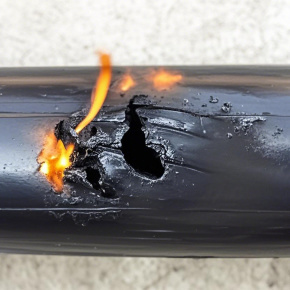
Information
How does the "lifeline" of new energy cables withstand risks?
Release time: 2025-02-14
In recent years, the new energy vehicle industry has developed rapidly.By January 2025, the wholesale penetration rate of new energy vehicle manufacturers had reached 42.3%, and it is expected that the annual penetration rate will exceed 57%. However, accompanying the surge in sales are frequent spontaneous combustion incidents—statistics show that in 2024, there were over 30 fire incidents involving domestic new energy vehicles, including brands such as Zeekr, Xiaopeng, and Tesla, with 99% of the fires related to the battery system. The safety performance of cables, as the "blood vessels" of energy transmission, is directly related to the overall safety of the vehicle.
1. Safety Hazards of Cables in Spontaneous Combustion Incidents
- Collision and Puncture: The"Deadly Weakness"
In August 2024, a certain brand's Deep Blue SL03 caught fire due to the chassis cable being pierced by sharp stone bricks, leading to a short circuit in the battery; in November of the same year, a Zeekr 009 caught fire due to damage to the battery cable from a high-speed collision with a metal foreign object. These cases reveal that new energy cables need to have extremely high impact and puncture resistance. The thickness and material strength of traditional cable protective layers are difficult to meet the requirements, while new energy cables need to enhance protection levels through multi-layer armor, high-toughness insulating materials (such as cross-linked polyethylene), and anti-collision structural design.
- High Temperature and Overload: The"Thermal Runaway" Risk
Lithium batteries are prone to thermal runaway in overcharging or high-temperature environments, and the temperature resistance of cables, as current transmission carriers, is crucial. For example, a certain model experienced a local temperature exceeding120℃ due to insufficient heat dissipation of the charging pile cable, leading to the melting of the insulation layer and a short circuit. According to the "Safety Requirements for Conductive Charging Systems of Electric Vehicles" (GB44263-2024), charging cables must pass high-temperature durability tests (such as -40℃ to 125℃ cycle tests) and use liquid cooling technology or high-temperature resistant silicone materials to cope with extreme conditions.
- Insufficient Flame Retardancy of Materials: The"Accomplice" of Fire Spread
If the insulation layer of new energy cables uses ordinaryPVC materials, it is flammable and releases toxic gases when exposed to fire. In a fire incident involving an electric bicycle in 2024, the burning of cable materials led to a rapid spread of the fire, causing serious casualties. In response, the GB17761-2024 standard clearly requires that non-metallic materials of cables must reach V-0 level flame retardancy (self-extinguishing within 30 seconds in vertical burning tests), and the oxygen index must be ≥26% to suppress combustion.
2. Upgrading and Challenges of New Energy Cable Safety Standards
- National Standards Accelerate Improvement
- Power Battery Cable Testing: The"Safety Performance Inspection Regulations for New Energy Vehicles"(GB/T44500—2024), effective in March 2025, will include insulation resistance, potential balance, and other items in the annual inspection of battery cables, requiring cables to remain stable under high voltage (such as 1500V).
- Charging System Safety Specifications: TheGB44263 standard, effective in August 2025, sets higher requirements for the electrical safety, mechanical strength, and environmental adaptability of charging cables, such as requiring the charging gun to withstand over 10,000 insertions and the outer shell to reach an IP58 protection level.
- Innovation in Materials and Processes
- Environmentally Friendly Flame Retardant Materials: Halogen-free low-smoke cables (such asTPE, XLPO) are expected to exceed 30% market share by 2025, with 80% reduction in smoke toxicity during combustion, making them more compliant with safety requirements in construction and transportation.
- Intelligent Monitoring Technology: Some car manufacturers have introduced distributed fiber optic temperature measurement systems to monitor cable temperature changes in real-time, providing early warnings for abnormal hot spots, which can reduce fire risks by70%.
- Industry Pain Points: The Game of Cost and Standards
- Some manufacturers, in order to cut costs, use"borderline compliant" lightweight materials, leading to accelerated aging of cables after long-term use. For example, a certain brand's cable had an insulation layer thickness of less than 0.6mm (the national standard lower limit), resulting in leakage in a humid and hot environment. Experts call for mandatory certification (such as CCC) and dynamic sampling inspections to ensure safety throughout the entire lifecycle.
As the "lifeline" of energy transmission for new energy vehicles, the importance of their safety performance is self-evident. In the face of frequent spontaneous combustion incidents, we must take multiple measures to strengthen the safety protection of new energy cables. From enhancing the impact and puncture resistance of cables to improving temperature resistance and material flame retardancy, every step is crucial. At the same time, as safety standards for new energy cables continue to upgrade, we also need to actively promote innovation in materials and processes to meet higher standard requirements. However, industry pain points still exist, and the game of cost and standards has led some manufacturers to choose compromise. To ensure the safety of new energy cables throughout their lifecycle, we must strengthen supervision and eliminate safety hazards through mandatory certification and dynamic sampling inspections. Only in this way can we provide a solid guarantee for the sustainable and healthy development of the new energy vehicle industry, making new energy vehicles a truly safe, reliable, and environmentally friendly travel choice.
 oversea@hichain.com.cn
oversea@hichain.com.cn
 +8617328576881
+8617328576881










